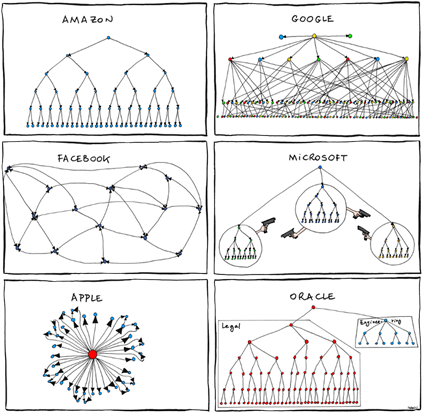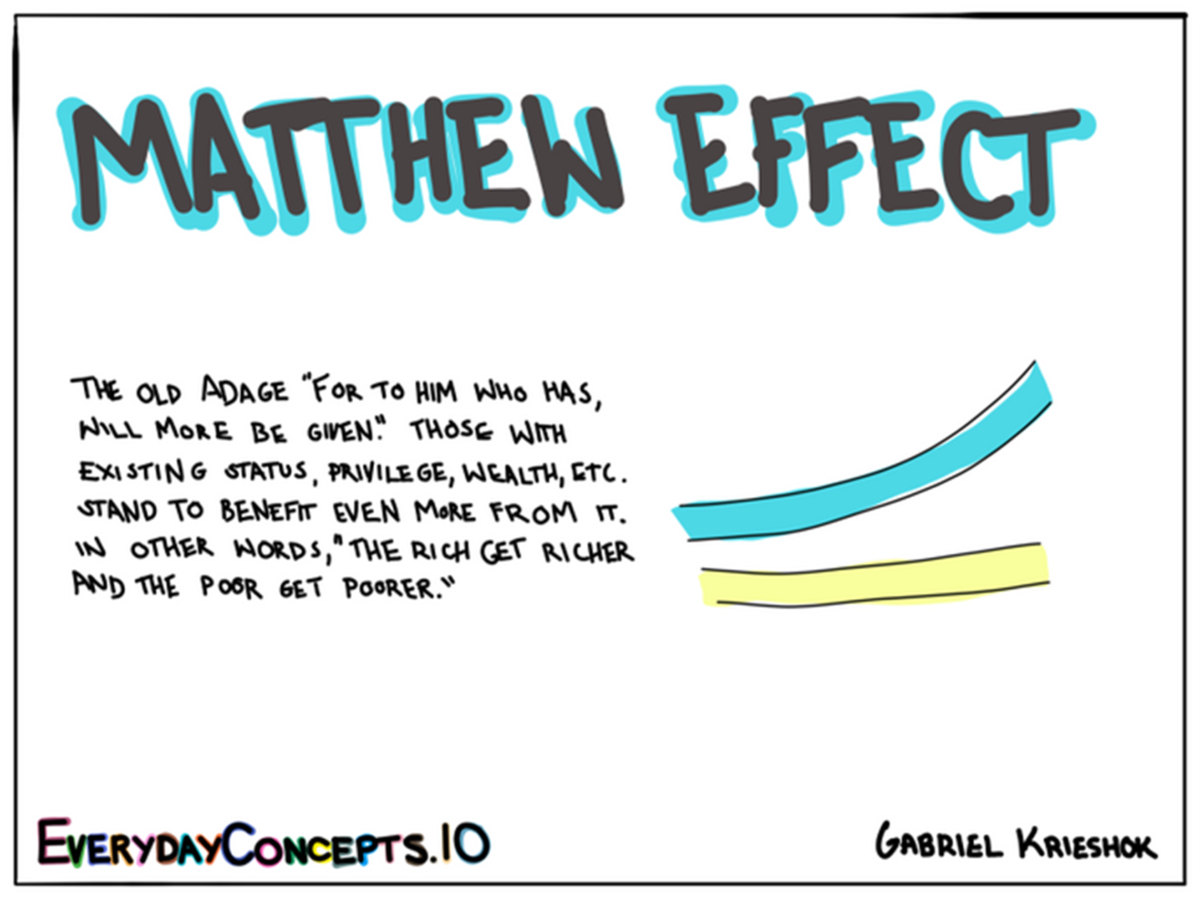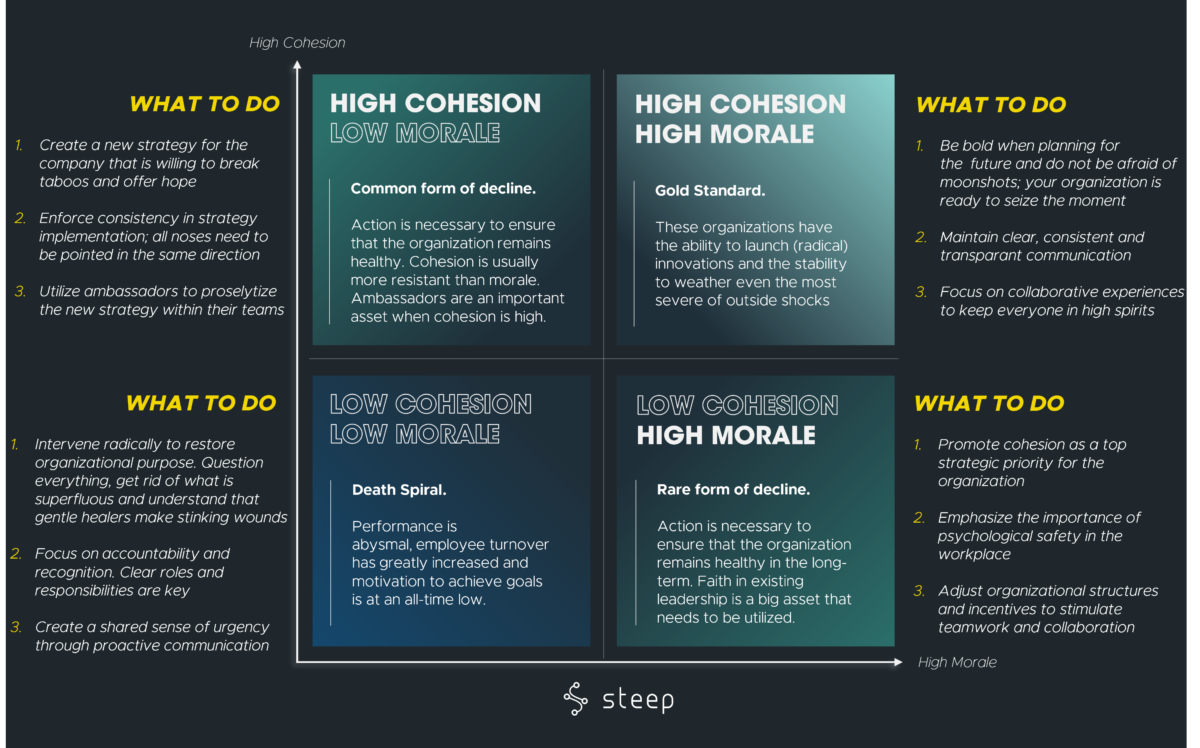Table of contents
von Clausewitz on Morale and Cohesion
Modern definitions of Morale and Cohesion
- A common definition of morale in military context
- A common definition of cohesion in military context
The Relationship Between Morale and Cohesion in a business context
- Why is morale important for business management?
- Why is cohesion important for businesses management?
- The correlation between Cohesion and Morale in organizations
The 4 types of organizations depending on their Morale and Cohesion
The Morale / Cohesion Matrix’s implications for Change Management
- How to manage change in organizations with High Cohesion & High Morale
- How to manage change in organizations with Low Cohesion & Low Morale
- How to manage change in organizations with Low Cohesion and High Morale
- How to manage change in organizations with High Cohesion and High Morale
Introduction
Google Sun Tzu’s The Art of War and you will come across a wide array of articles and books extolling the lessons of this ancient Chinese text for today’s business leaders. The same can be said for a bunch of other books (e.g., Machiavelli’s Il Principe) which were written in vastly different contexts than the one we are currently living in.
Normally, the reappraisal and re-engagement of old texts is a laudable endeavor. However, we must acknowledge that there is a whole cottage industry which seeks to “rediscover” old books, reduce them into easily marketable soundbites and then sell readers said soundbites as a quick fix for their very real problems.

Most of the predatory self-help writers that use this trick sadly fail to enter into a critical dialogue with the texts they steal from. Their readings are at best superficial and vague, while their audacious claims of discovering the essential/universal/eternal truths encoded in a text by ancient authors for modern audiences feel a bit too much like those of the conspiracy theorists who pop up after every major catastrophe claiming that 16th century seer Nostradamus predicted the cataclysmic events in question in his 1555 work Les Prophéties (they always do this post-fact however, never before).
While it would be beyond the scope of this article to delve deeper into something like Roland Barthes La mort de l’auteur to explain a far more rewarding and honest way of re-engaging with texts old and new, we would like to use this article to try something different.
Instead of trying to cram a square peg into a round hole, we shall take a look at an old text – in this case Carl von Clausewitz seminal book On War – and examine a specific piece of nomenclature that was first introduced by the book in question and then further redeveloped by others into a form that is useful for thinking about some of the challenges in today’s business landscape.
The first concepts that we have chosen for this treatment are morale and cohesion. As we shall see further in the text, these terms can be used to create a simple 2×2 Matrix framework that allows us to separate high-performing organizations from those in relative and terminal decline.
von Clausewitz on Morale and Cohesion
For this first attempt, we decided not to go easy on ourselves. We therefore chose to take a closer look at what eminent Prussian general Carl von Clausewitz had written on the subject of morale and cohesion.
These concepts are not clearly delineated from one another in his work but are rather grouped together under the more general term moral powers or forces. A term that frequently pops up in his writings and is deemed of the utmost importance for success:

QuoteVon Clausewitz GeneralWar in its literal meaning is fighting, for fighting alone is the efficient principle in the manifold activity which in a wide sense is called War. But fighting is a trial of strength of the moral and physical forces by means of the latter. That the moral cannot be omitted is evident of itself, for the condition of the mind has always the most decisive influence on the forces employed in War. (Book II, chapter 1)
There are many other concepts and definition within von Clausewitz body of work that have been further developed throughout the years. First in a purely military context and later on elsewhere. The man is rightly seen as the father of strategy as a discipline and perhaps we shall explore some of the potentially useful concepts for corporate strategy and other fields in a series of articles down the road.
For the time being, however, we decided to focus on morale and cohesion in this article due to their relevance to the “hard” returning problems in change management projects, particularly in organizations in terminal decline.
As we can read in the quotation above, von Clausewitz thought that morale and cohesion were always decisive in any conflict. While a strong technological edge, deep pockets and clever stratagems are not to be disregarded entirely, they are of no use if they do not break your opponents will to fight.
While the stakes in economic competition are clearly different (and certainly a lot lower) than any military conflict, we will argue that the same can be said of success in the corporate world. Enterprises in which employees do not believe in management’s capacity to deliver success and who do not cooperate well together will flounder, even if they work for companies with big budgets, large R&D units and lots and lots of fancy slide decks made by premier strategy consultants.
It therefore stands to reason that organizations need to put the work in to maintain morale and cohesions at levels that are high enough to ensure continued success. This is particularly true for organizations that are going through phases of relative and even terminal decline. In organizations that are buoyed on by strong market forces, morale and cohesion is more easily maintained than organizations that have stopped growing and are in need of reinvention.
This is rather unfortunate, as it is just in times of crisis that good morale and cohesion can make all the difference between an organization becoming another Apple (the most successful reinvention story in corporate history) or to suffer the same faith as Kodak (or any of the other countless companies that went from relative to terminal decline without being able to turn around).
Modern definitions of Morale and Cohesion
Now that we have taken our time to discover the antecedents of morale and cohesion (cf. von Clausewitz moral forces), it is time to zoom in on the modern definitions. We shall do this in the section below.
A common definition of morale in military context
QuoteDevereaux, 2022Morale is the commitment the combatants have to their leadership and their cause
As you can clearly tell, this is still very much a military definition. In the context of businesses, morale is therefore often narrowed down to employee morale or more appropriately to workplace morale.
There is a lot of contention about the proper definition of workplace morale, mainly because it is hard to quantify a question of emotions. In general, however, there is a great deal of scientific consensus about the fact that workplace morale can have impacts on productivity, profitability, job satisfaction, job frustration, job motivation, job attitudes, turnover rates and group dynamics.
Depending on whether morale is high or low, these impacts can be either positive or negative. Employees with high morale bring a lot of benefits to employers, as they are more productive, committed and satisfied with the firm, its activities and their role within them. Employees with low morale on the other hand, are more likely to be a drag on performance, bringing little benefit to their employers as they are less productive.
A common definition of cohesion in military context
Now that we have defined workplace morale, it is important to now take a look at the related concept of cohesion.
QuoteDevereaux, 2022Cohesion is the force that holds a specific unit together through the power of the bonds holding the individual combatants to each other and/or to their (generally junior or non-commissioned) officers.
Unlike morale, which has been clearly translated into an economic concept through the focused nickname of workplace/employee morale, there is less differentiation when it comes to cohesion.
In management literature, there is however a lot of emphasis on team cohesion. Again, this is mostly a positive focus in the sense that teams that work well together display high degrees of cohesion. They stick together during stressful circumstances and are more willing to admit mistake and subordinate their own interests to those of the group (and thus normally the firm) as a whole.
Now that we have defined the two concepts, we have to establish the relationship between the two concepts, as this was left somewhat fuzzy in von Clausewitz’ writings and is only really made clear in later works.
The Relationship Between Morale and Cohesion in a business context
As stated earlier, morale and cohesion are related concepts. In high-performing organizations, both morale and cohesion are high. That means that people believe in their organizational cause and leadership (high morale) on the one hand and are dedicated to supporting their team mates on the other hand (high cohesion).
The relevance of both cannot be underestimated and they are important throughout the full spectrum of organizational activities employees typically encounter. They shine however, on slightly different aspects.
Why is morale important for business management?
Employees who believe that their management is making the right call and who believe that their organization is contributing to a laudable end will however be willing to keep on making this sacrifice and thus help advance the organization’s cause.
Morale is important in the long-run, and it is particularly necessary for people to apply themselves to the slow, boring and grinding tasks (e.g., administration and paperwork in general) that most of us regret, but which are to some degree inevitable and essential for organizations to move forward.
Why is cohesion important for businesses management?
Cohesion on the other hand, is particularly important in times of crisis. While in normal periods, highly cohesive teams deliver better results and usually have greater degrees of psychological security (which for example has an impact on how successful it can leverage open innovation), it is during stressful periods in which undue pressure and anxiety rear their ugly heads that cohesive teams will keep on performing past the limit of individual endurance because no one wants to let their team mates down.
Cohesion thus strengthens organizational resilience and can be a real source of competitive advantage. If you are writing an important funding proposal while everyone is under a lot of stress, organization with high cohesion are far more likely to deliver outstanding results than organizations with low cohesion.
The correlation between Cohesion and Morale in organizations
High morale and high cohesion are usually correlated, as both are hallmarks of successful organizations. The same can be said for low morale and low cohesion, as these are typical for underperforming organizations. This is particularly true in organizations that have been underperforming for a while, as cohesion takes longer to decrease than morale.
Organizations that enter into a phase of relative decline typically see a drop in morale long before their cohesion breaks down. Once cohesion really starts to collapse however (e.g., because of the departure of keystone employees), the writing is on the wall and the organization enters a period of terminal decline from which it is very hard to recover.
The 4 types of organizations depending on their Morale and Cohesion
Putting all these factors together, we can group all organizations in one of the four categories below based on how high their morale and cohesion are:

We have already talked at length about both organizations in terminal decline and high-performing organizations. In the remaining paragraphs of this section, we will also take a look at organizations in the two quadrants that we have collectively chosen to dub Relative Decline.
Organizations with Low Cohesion and High Morale
Let us start in the bottom right quadrant, where we place the organizations that are high in morale, but low in cohesion. This is a most unusual state for an organization to find itself in, as human beings tend to stick together and form social bonds even in the most adverse of circumstances (i.e., the bottom left quadrant of our figure). When morale is high and success is reasonably sure, it tends to be easier to form bonds not harder.
The example of Microsoft as an Organization with Low Cohesion and High Morale
While organizations seldomly find themselves in this quadrant, there are always examples to be found. The best example of all is probably Microsoft in the early 2000s. At the time (and still today), Microsoft was one of the most successful corporations to have ever existed. Unlike the present day however, there was a clear issue at Microsoft. It was not that there was a lack of great ideas (e.g., Microsoft had introduced forerunners to both the iPad and iPhone at this stage, although it was Apple’s later efforts that went on to truly transform the world), nor did Microsoft at the time suffer from a dearth of resources or lacked a strong culture.
The issue that plagued Microsoft at the time was most elegantly summed up by the meme below which compared the organizational charts and cultures of the various tech giants with one another.

It stands to reason that an organization in which the various departments have a gun aimed at each other (a pastiche of Microsoft vehement and often destructive internal competition) would score rather poorly on any measure of cohesion.
Microsoft’s problems then, were caused by their inability at the time to truly band together and to bring all the brilliant ideas they had to full fruition. This led to a time of relative decline in which Microsoft had to give way to Apple.
Fortunately for Microsoft, their relative decline was checked by the appointment of new CEO Satya Nadella in 2014. One of the many challenges Nadella faced head on from his first day was to find a way to transform the aggressive and bitter organizational culture and discover a new purpose to animate the organization and to reorient it towards a more cooperative approach that would allow it to succeed where so many of its previous bets had failed.
Given the fact that Microsoft is currently the third most valuable publicly listed company in the world (behind only Apple and Saudi Aramco at the time of writing) and is handsomely competing in a multitude of old and new operational theatres (its Azure cloud platform succeeding where its search engine and certainly its mobile operating system failed), we can say that Nadella’s reformist zeal carried the day.
Organizations with High Cohesion & Low Morale
Now that we have discussed the bottom right quadrant of our figure, it is time to examine the other yellow-colored square. This one is the high cohesion, low morale quadrant (HCLM) and can be found in the top left corner of our figure.

While it is hard to find many organizations that occupy the LCHM quadrant, it is much easier to find organizations that occupy the HCLM quadrant. Aside from the highly maligned zombie firms (which pass through this stage on their way to the terminal decline of the LCLM quadrant), HCLM organizations make the news on a continual basis, as these are usually the type of companies that are plagued by strikes and other forms of social discontent.
The example of Renault as an Organization with High Cohesion and Low Morale
The quintessential exemplar in the Belgian context is probably French car manufacturer Renault and the highly publicized closure of its great Belgian factory in Vilvoorde.
At the time, the Renault group was in real trouble and serious cuts were necessary to protect the future of the company as a whole. The employees in Vilvoorde understood that the situation was not great, and morale was quite low at the time as some lay-offs seemed inevitable.
The bomb no one in Vilvoorde was expecting however, was the closure of the entire plant, putting over 3.000 people out of work in one fell swoop. While this dealt a deadly blow to what little morale was left, the employees rallied together to fight for their jobs. In an incredible display of cohesion, workers organized protests (including a march of over 10.000 people on Renault’s HQ in Paris and a march of 70.000 people in Brussels to denounce the government’s less than stellar employment record) and kept on fighting for their jobs for several months.

Even though the ending for the people at Renault was not positive, it is a notable example of the power a cohesive group of people can conjure up when pressed upon. As many executives have experienced in the past, it is better to channel the cohesive animal spirits of people into something productive rather than ending up locked into a battle with it. Victory is certainly possible, but it will often be a pyrrhic one — one that comes at a cost so great, it maybe makes the win not worth it
The Morale / Cohesion Matrix’s implications for Change Management
Change is inevitable. Regardless of which quadrant of the Morale / Cohesion Matrix your organizations land on, the fast-evolving business landscape will necessitate frequent rollouts of new services, products, and practices to keep up with (and preferably even ahead off) the competition.
In some organizations however, this is easier than in others. That is where the Morale / Cohesion Matrix comes in.
Accurately pinpointing in which quadrant your organization is located will not only help you to quickly estimate how difficult the road ahead will be, but it will also provide you with a clear understanding of what your organization’s primary focus should be. This in turn will allow you to utilize scarce resources more effectively, thus increasing the change of success.is situated will help you quickly estimate how difficult the road ahead will be.

In change management, like so many other areas in life, good fortune is not distributed equally. Indeed, we would not be amiss to speak of a veritable Matthew effect in which high-performing organizations will much more easily submit to change.
How to manage change in organizations with High Cohesion & High Morale
After all, in high-performing organizations employees trust the company and its management, and thus they will be much more willing to cooperate with a new change. Furthermore, due to their high cohesion these organizations will benefit from higher degrees of self-effacing and altruistic behaviors to support struggling colleagues to adapt to the new status quo.
How to manage change in organizations with Low Cohesion & Low Morale
In stark contrast, organizations in terminal decline will find it far harder to adjust. Since their belief in management is low and because there is only limited support between colleagues, it will be extremely difficult to make any changes stick. Many will just refuse to adopt them and even amongst those who make the effort, many will revert back to their old ways the first chance they get.
The one advantage a change manager has in such trying circumstances is the fact that sometimes there is a particularly great sense of urgency in these types of organizations. It is often easier to radically change an organization than to work around the edges as it were. Thus some of the adversity can be overcome on the condition that the problems are clearly recognized (which is distressingly rare).
How to manage change in organizations with Low Cohesion and High Morale
For the organizations in relative decline, there is a difference between the HCLM and LCHM quadrant. Organizations in the LCHM quadrant will usually be relatively easy to change if the right conditions are met. First and foremost, that of sponsorship. In these LCHM organizations, there is usually a high degree of faith in management. It will therefore be relatively easy to accept a change that has been sponsored by the top of the company. The troubles start however, as soon as a change is demanded bottom-up or reaches a department laterally. There the low cohesion will make it difficult to move ahead with the implementation.
It is therefore crucial to gain top-level sponsorship when embarking on a big change project in an LCHM organization and to utilize the halo effect of this top-level sponsorship to not only push through the change but to also demonstrate the benign effect of working alongside each other towards a common goal.
As an executive in such an organization, fostering cohesion in any new initiative should be at the top of your to-do list. Failing to restore cohesion will otherwise lead to ever-increasing coordination issues, sap your innovative potential and put you on the long road to terminal decline.
How to manage change in organizations with High Cohesion and High Morale
The toughest nut to crack in the whole Morale / Cohesion Matrix is the HCLM quadrant. While it would not be remiss to advise any outside change manager to run for the hills when faced with this type of organization, there are ways to facilitate change even in this type of inhospitable environment.
Why is this quadrant in particular is so difficult? When you are pushing a change in an organization with low morale, you will undoubtedly be viewed with suspicion. Usually, this suspicion can be waylaid by proper sponsorship, but in organizations in which management is not trusted anymore that sponsorship will hardly help and might even be counterproductive.

What makes matters worse in the HCLM quadrant is that the high cohesion usually ensures that the distrust of management is widely shared and that people who are resistant to change to the point of obstinacy are excused (sometimes supported) by their colleagues. There is often a tendency in these type of organizations for employees to behave like a prodded hedgehog and to – figuratively speaking – roll themselves into a spiny ball to ward of changes.
As a change manager in these situations, it therefore pays off to stress and demonstrate your autonomy towards the people you will have to guide towards a desired end goal. This is particularly useful when you are an external change manager embedded into an organization to turn projects around the companies’ own staff cannot handle. In these circumstances, your lack of bonds with the companies’ management (together with a not inconsiderable quantity of diplomatic acumen) will be necessary to efficiently and effectively ensure the adoption of any proposed change.
Conclusion
Morale and cohesion are important factors any good (change) manager keeps an eye on. As stated earlier, low morale and lack of cohesion can have devastating effects on organizations indicating and/or leading towards relative and even further, terminal decline.
Keeping tabs on morale and cohesion requires real skill, as von Clausewitz himself already indicated that the impact of moral forces is not easily quantifiable:
Quote:Von Clausewitz GeneralThe spirit and other moral qualities which animate an army, a general, or governments, public opinion in provinces in which a war is raging, the moral effect of a victory or of a defeat, are things which in themselves vary very much in their nature, and which also, according as they stand with regard to our object and our relations, may have an influence in different ways (Book III, chapter 3).
The fact that it is difficult to do something, however, does not make it any less important. Especially when there are frameworks like the Morale / Cohesion Matrix that can help reduce complexity and that make you grasp the severity and patience that will be needed to bring about any change.
For any manager building or inheriting a high-performing organization, it will be key to ensure that morale and cohesion remain high. Conversely, any manager unfortunate enough to come into an organization in relative or even terminal decline will have to take their time to restore confidence in their leadership (and thus increase morale) and to shore up the essential cohesion of their people. Only then will they be able to weather the storm and start slowly turning the organization around.


Arjan Keijser is a Senior Innovation & Change Management Consultant at SteepConsult
After having amassed a wealth of experience in Innovation & Change Management, Arjan joined SteepConsult to support our transition towards an innovative, solution-oriented, and sustainable future. As our in-house intellectual, he enjoys sharing his knowledge with customers and colleagues alike.
Reference List
Barthes, R. (1968). La mort de l’auteur. Manteia, 5, 12-17.
Black, J., Kim, K., Rhee, S., Wang, K., & Sakchutchawan, S. (2018). Self-efficacy and emotional intelligence: Influencing team cohesion to enhance team performance. Team Performance Management: An International Journal.
Boel, L. (2017). Hoe een onverwachte mededeling de start was van een maandenlang gevecht om een sociaal drama te vermijden. Het Nieuwsblad. Retrieved from here
Britt, T. W., & Oliver, K. K. (2013). Morale and cohesion as contributors to resilience. In R. R. Sinclair & T. W. Britt (Eds.), Building psychological resilience in military personnel: Theory and practice (pp. 47–65). American Psychological Association.
Devereaux, B. (2022). Collections: Total Generalship: Commanding Pre-Modern Armies, Part IIIc: Morale and Cohesion. Retrieved from here
Edmondson, A.C. (2018). The Fearless Organization: Creating Psychological Safety in the Workplace for Learning, Innovation and Growth. Wiley.
Favarra, G., Minoiu, C., & Perez-Orive, A. (2021). U.S. Zombie Firms: How Many and How Consequential? FEDS Notes. Retrieved from here
Guardian Editorial (1999). Nostradamus wrong (Please ignore if the world ended yesterday). The Guardian. Retrieved from here
Howitt, P. (2002). Looking inside the labor market: A review article. Journal of Economic Literature, XL, 125-138.
Kappel, M. (2017). How To Boost Workplace Morale At Your Business. Forbes. Retrieved from here
Kenton, W. (2021). Zombies. Investopedia. Retrieved from here
McKenna, A. (s.d.). Nostradamus and His Prophecies. Britannica. Retrieved from here
Nadella, S. (2017). Hit Refresh: The Quest to Rediscover Microsoft’s Soul and Imagine a Better Future for Everyone. Harper Business.
Olivetta, E. (2017). Leadership, Morale and Cohesion: What Should Be Changed? In: Holenweger, M., Jager, M., Kernic, F. (eds) Leadership in Extreme Situations. Advanced Sciences and Technologies for Security Applications. Springer, Cham.
Pietersen, W. (2016). Von Clausewitz on War: Six Lessons for the Modern Strategist. Ideas at Work. Colombia Business School. Retrieved from here
Pulizzi, J. (2019). What Really Turned Apple Around. Retrieved from here
Sania, U., Kalpina, K., & Javed, H. (2015). Diversity, employee morale and customer satisfaction: The three musketeers. Journal of Economics, Business and Management, 3(1), 11-18 Retrieved from here
Surur (2019). Apple did not invent the smartphone: A Eulogy for Windows Phones. Retrieved from here
von Clausewitz, C. (1997). On War (J. J. Graham, Trans.). Wordsworth Editions.
von Clausewitz, C. (2006). On War. Project Gutenberg. Retrieved from here
Weinberger, M. & Hartmans, A. (2020). Steve Jobs would have been 65 on Monday. Here’s how the late Apple CEO saved the company from disaster and set it on the path to a $1 trillion valuation. Business Insider. Retrieved from here
Wikipedia (2022). Strijd voor Arbeid. Wikipedia. Retrieved from here
Yarrow, J. (2011). The Org Charts Of All The Major Tech Companies (Humor). Business Insider. Retrieved from here


